Night Heron

Black-crowned Night Heron Nycticorax nycticorax
Etymology :
- Nycticorax : Greek word for bird of evil omen derived from nuktos – night; korax- raven.
- Nycticorax : Greek word for bird of evil omen derived from nuktos – night; korax- raven.
Vernacular Names : Sind: Gadri, Hindi: Waak, Kwaak, Tar or Taal bagla, Kokrai, Sans: Nakht bak, Kash: Bor, Pun: Chor bagla, Ass: Waak chorai, Ben: Bachka, Mani: Chongkhu, Guj: Awaak, Waak, Mar: Raat baggal, Raat kokku, Kvarf, Ratdhokri Ori: Rati baga, Ta: Vakka, Te: Chinta wakha, Mal: Toppi kokku, Kan: Nisha baka, Sinh: Rekana kokka
Distribution in India: Wide spread resident except for Himalayas, winter visitor to central india.
Description: Size 56–65 cm; wt. of 278–1100 g; wingspan of 105–112 cm. It has a black cap, white head– and white neck-sides, black mantle, dark grey upperwings, rump and tail, and white or pale grey belly. The legs are red and lores are black during courtship, while black of head and back acquire blue-green gloss during this breeding period and white head plumes are well developed. The female is smaller and lighter, with shorter nuchal plumes. The non-breeding adult has cap and back duller, lacks nuchal plumes; black bill, greenish-blue lores, crimson-red eyes and pale yellow legs and feet. The juvenile is spotted and streaked brown, grey, buff and whitish; upperwing is grey-brown with paler spotting, flight feathers are also grey-brown with white tips, rump is grey-brown streaked white, tail is grey, and underparts are grey streaked dark brown. It acquires adult plumage gradually over 2–3 years, with subadult plumage much like adult, but drabber and browner, with little or no black above, and diffuse dusky and whitish streaking on neck and wing-coverts. The lores are green, eyes initially orange-yellow to brown-red, becoming red with time, maxilla is black with yellow or green cutting edges, mandible is horn-coloured, becoming yellow-green with black tip or yellow with horn tip at one year old, then black in second year, while legs and feet are initially yellow-green to olive-green, becoming yellow in second year.
Habitat: It is found in waterbodies like tanks, lakes, streams, Mangroves and coastal lagoons.
Food Habits: It stands still at the water’s edge and wait to ambush prey, mainly at night or early morning. It eats small fish, crustaceans, frogs, aquatic insects, small mammals, and small birds. During the day it rests in trees or bushes
Breeding Habits: They nest in colonies on platforms of sticks in a group of trees, or on the ground in protected locations such as islands or reed beds. Three to eight eggs are laid. Both male and female incubate the eggs and the chicks are born Altricial (with closed eyes and less down feathers). Both parents do the duty of feeding the chicks. The chicks fledge within 3 weeks and leave the nest post fledging within 21 days.
They are Crepuscular and nocturnal except during feeding the young. They spend the daytime in shade of the thick foliage or inside shrubs and reeds.